Zeta Reticuli (ζ Ret) is a wide double star located in the southern constellation Reticulum. The star system is composed of two Sun-like stars, Zeta1 and Zeta2 Reticuli, located at a distance of about 39.3 light years from Earth. The yellow dwarf stars have apparent magnitudes of 5.52 (Zeta1) and 5.22 (Zeta2) and are visible without binoculars from areas without light pollution.
Even though the Zeta Reticuli system has been the target of several planet hunting projects, no planets have been confirmed orbiting either star to date.
Star system
The Zeta Reticuli system consists of two yellow main sequence stars of spectral types G3-5V and G2V. Both components of the wide binary star system are younger than the Sun. They have an estimated age between 1.5 and 3 billion years.
Designated Zeta1 and Zeta2 Reticuli, the two solar analogs are slightly smaller, less massive and less luminous than the Sun. Zeta1 lies at a distance of 39.28 light years, while Zeta2 is 39.27 light years away. The stars share similar radial velocities and proper motions, indicating that they form a physical system and have a common origin.
Zeta1 and Zeta2 Reticuli are separated by 309.2 arcseconds on the sky and appear as a close double star to the unaided eye in good conditions. The angular separation between the yellow dwarfs corresponds to a physical distance of at least 3,750 astronomical units (0.06 ly). This is equivalent to almost a hundred times the distance from the Sun to Pluto. The two stars complete an orbit around a common centre of mass every 170,000 or more years.
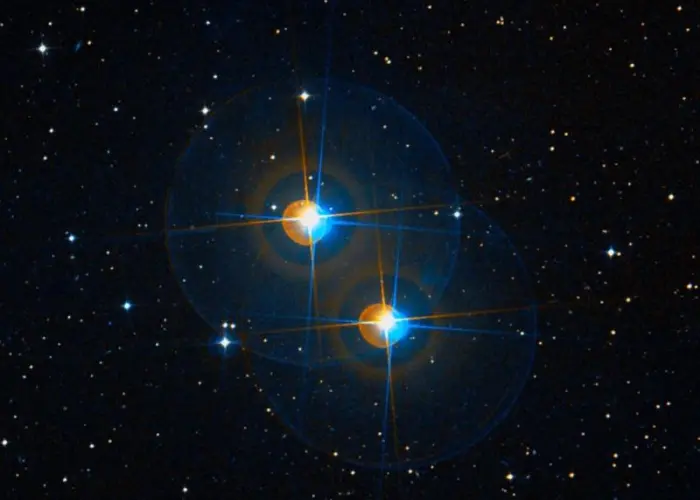
Zeta Reticuli, image credit: ESO/Digitized Sky Survey 2 (CC BY 4.0)
Zeta1 Reticuli has a mass of 0.94 solar masses and a radius of 0.90 solar radii. With an effective temperature of 5,729 K, it shines with 0.761 solar luminosities. The star has a projected rotational velocity of 2.2 km/s.
Zeta2 Reticuli is slightly larger and more massive, with a size of 0.98 solar radii and a mass of 0.96 solar masses. With a surface temperature of 5,861 K, it has 97.2% of the Sun’s luminosity. It spins at 1.74 km/s.
Both Zeta1 and Zeta2 Reticuli are slightly metal deficient. They have only about 60% of the Sun’s metallicity. Both stars have severely low abundances of beryllium.
Beryllium is one of the elements that are destroyed by nuclear fusion in the interiors of stars. Very young stars have the beryllium they were born with and, as they get to an older age, they destroy up to 85% of their beryllium. The presence of the element on the stellar surface reveals how deeply the surface layers extend into the interior.
A study published in 2012 suggested that beryllium depletion may either be a result of early accretion or rotational mixing. In the first scenario, when they were still protostars, the stars underwent many intense bursts of mass accretion from the protostellar cloud, which increased the temperature at the bottom of their convective envelopes, consequently increasing beryllium destruction. In the second case, they had high rotational velocities in their youth and underwent rotational mixing, with a radial flow of mass transporting angular momentum and chemical composition.
A 2005 study that constructed chromospheric models of solar analogues found an intermediate level of magnetic activity in the chromosphere of Zeta1 Reticuli.
A 2018 study of the long-term activity of the Zeta Reticuli system found an activity cycle with a period of about 10 years in Zeta2 Reticuli, comparable to the Sun’s (about 11 years). The study also revealed an eccentric variability in the more active Zeta1 Reticuli.
A 2020 study based on two decades of observations with the HARPS, REOSC, UVES, and FEROS spectrographs found a high activity level for Zeta1 Reticuli and a significant decrease in the magnetic activity cycle amplitude of Zeta2 Reticuli. The astronomers found a period of 4.2 years for Zeta1 and 7.9 years for Zeta2. They proposed that the decreasing amplitude in the activity of Zeta2 Reticuli may be evidence that the star is in a Maunder Minimum (MM) state.
The MM state is a prolonged sunspot minimum observed in the Sun when sunspots became very rare between 1645 and 1715. Zeta2 Reticuli is the first MM candidate detected through discrepant activity in a binary star system.
A 2002 study of stars with low chromospheric ages and high kinematical ages suggested that both stars in the Zeta Reticuli system were about 2 billion years old. The stars have active chromospheres, which indicates that they are young, but their lithium abundance is lower than expected in young stars. Like beryllium, lithium gets depleted with age, and a low abundance indicates a more advanced age.
Planets
Zeta Reticuli does not host any confirmed exoplanets. On September 20, 1996, a hot Jupiter (a gas giant with a short orbital period) with 27% of Jupiter’s mass was reported to be orbiting Zeta2 Reticuli at a distance of 0.14 astronomical units with an orbital period of 18.9 days. However, the discovery was dismissed only two days later. The signal that was detected was not caused by a planet, but by the star’s pulsations.
For a planet to be in the habitable zone of Zeta2 Reticuli, it would need to orbit at a distance of 1 astronomical unit (Earth-Sun distance), which would give it an orbital period of a little more than a year.
A planet in the habitable zone of Zeta1 Reticuli would need to be slightly closer to its host star, at 0.9 astronomical units. At that orbital distance, it would complete an orbit every 320 days.
In 2002, an ISO 25 μm photometric survey of nearby main sequence stars searching for the presence of Vega-like warm dust disks did not find an infrared excess around Zeta1 Reticuli. Circumstellar disks are indicators of possible planets orbiting the host stars.
Observations with the Spitzer Space Telescope in 2007 detected an infrared excess around Zeta2 Reticuli at 70 μm, indicating a dusty debris disk with a temperature of about 150 K, that appeared to be orbiting the star at a distance of 4.3 astronomical units.
Observations with the Herschel Space Observatory in 2010 confirmed the discovery of a debris disk around Zeta2 Reticuli. The study concluded that the infrared excess emanated from a flattened two-lobed structure that appeared like a dust disk seen edge-on.
The structure appeared to orbit the star from a distance of about 70 to 120 astronomical units and was interpreted as an exo-Kuiper belt, in which icy bodies collide, producing dust. The study also reported asymmetry in the disk, which may indicate the presence of an unseen planet.
However, the presence of the debris disk was dismissed after observations with the Atacama Large Millimeter Array (ALMA), which showed that the double-lobed structure did not share a common proper motion with Zeta2 Reticuli. The study, published in 2018, concluded that the structure was most likely a background object.
Facts
Zeta Reticuli is a member of the Zeta Herculis Moving Group, a stellar association discovered by the American astronomer Olin J. Eggen in 1958. The group of stars formed in the same molecular cloud and they keep moving together through space. Named after what was believed to be the group’s brightest member, Zeta Herculis, the group also includes Eta Reticuli, Beta Hydri, Rho Persei, and Epsilon Octantis. Zeta Herculis itself is no longer considered to be part of the group.
The Zeta Reticuli system orbits though the Milky Way with an eccentricity of 0.24. As the stars orbit, they come within 17,400 light years of the Galactic Centre and move as far away as 28,600 light years. A 2008 study concluded that the inclination of their orbit puts the stars outside the Milky Way thick disk and that the system’s origin is uncertain.
Zeta Reticuli has been featured in numerous works of fiction. The best-known uses of the system include the Alien (1979) and Prometheus (2012) films, where Zeta2 Reticuli is the host star of Calpamos, a gas giant orbiting in the star’s habitable zone. Acheron (LV-426), the colony where the films are set, and LV-223 are two of the three moons orbiting Calpamos.
Zeta Reticuli was also memorably used in the television series Space: Above and Beyond (1995-96) and Seven Days (1998-2001).
In literature, the star system was referenced in the novels Forty Thousand in Gehenna (1983) by C. J. Cherryh and Silicon Embrace (1996) by John Shirley.
Zeta Reticuli in ufology
Zeta Reticuli is a familiar name in ufologist circles. The star system is associated with an alien abduction reported in the 1960s, as well as with alien conspiracy theories involving Area 51 and Project Serpo.
UFO conspiracy theorists believe that a planet orbiting Zeta2 Reticuli is the home of alien beings they call the Greys, who have been visiting our planet and abducting people for research purposes. An alien spacecraft purportedly crash landed in Roswell, New Mexico, in June or July 1947.
The Roswell UFO incident was first reported on July 8, 1947. The U.S. government attributed the incident to a weather balloon. In 1994, the U.S. Air Force stated that it was really a covert Air Force surveillance balloon.
The crash and the official sources changing their statements have given rise to numerous conspiracy theories. In the 1970s and 1980s, there were even witnesses who came forward and said that alien bodies were recovered from the site and autopsies were performed on the bodies. None of the witnesses had any evidence to back up their claims.
Zeta Reticuli is also at the centre of Project Serpo, an alleged exchange program between the U.S. government and an alien civilization from a planet in the Zeta Reticuli system, called Serpo. In ufologist lore, the Zeta Reticulan who crashed near Roswell survived the accident and was sent back home. This led to the establishment of the exchange program. As part of the program, twelve U.S. military personnel were purportedly sent to Serpo between 1965 and 1978.
Zeta Reticuli Incident
Another well-known case of a UFO sighting, known as the Zeta Reticuli Incident, took place in 1961. Betty and Barney Hill, a New Hampshire couple, claimed to have been abducted by aliens on the night of September 19 to 20, 1961. Their story, which did not initially involve Zeta Reticuli, was widely publicized and adapted into a book, The Interrupted Journey (1966) and later a television movie, The UFO Incident (1975).
The Hills reported seeing a craft descend toward them as they were driving home to Portsmouth from Niagara Falls and said that they were approached by several humanoid figures. They did not remember the events of the next few hours, but when they returned to consciousness, they were 35 miles south.
In 1964, under hypnosis, they recalled undergoing a physical examination by the aliens. Betty also remembered being shown a star map after asking the aliens where they came from. Her sketch of the map was included in The Interrupted Journey.
In the late 1980s, a man named Bob Lazar claimed to have been hired to reverse-engineer alien technology at site near Area 51 in Nevada. Additionally, he said that he had seen documents describing the relationship of Earth with Zeta Reticulans over the past 10,000 years.
While it gave fuel to hardcore conspiracists, Lazar’s story was dismissed by most, since even the universities where he claimed to have earned his degrees (MIT and Caltech) had no records that he had ever attended.
Zeta Reticuli map
In 1968, amateur astronomer Marjorie Fish used the 1969 Gliese Star Catalogue to construct a model of nearby stars based on Betty Hill’s map and found that the only star that matched the map was Zeta Reticuli.
Her conclusions found their way to the editor of Astronomy magazine and, in December 1974, the magazine published an article that started a debate about the map. Even American astrophysicists Carl Sagan and Steven Soter chimed in, saying that the map was an arbitrary alignment of points.
Betty Hill’s star map was definitively dismissed in the 1990s, when the Hipparcos satellite data showed that some of the stars in Fish’s interpretation of the map were located at much greater distances than previously believed. Later studies revealed that other stars included by Fish were unlikely to host life.
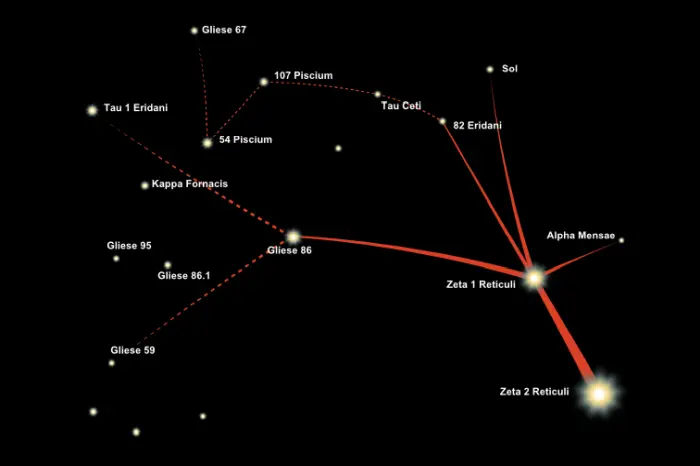
Zeta Reticuli star map, reproduction by Jeffrey Pratt from a lower-quality scanned image (CC BY-SA 2.5)
Location
Zeta Reticuli is not too hard to find in good conditions, but with a declination of −62° 30′, it never rises above the horizon for observers north of the latitude 28° N.
The star system is located in the area between Canopus and Achernar, east of the rhomboid asterism formed by the brightest stars of Reticulum, Alpha, Beta, Delta and Epsilon Reticuli.
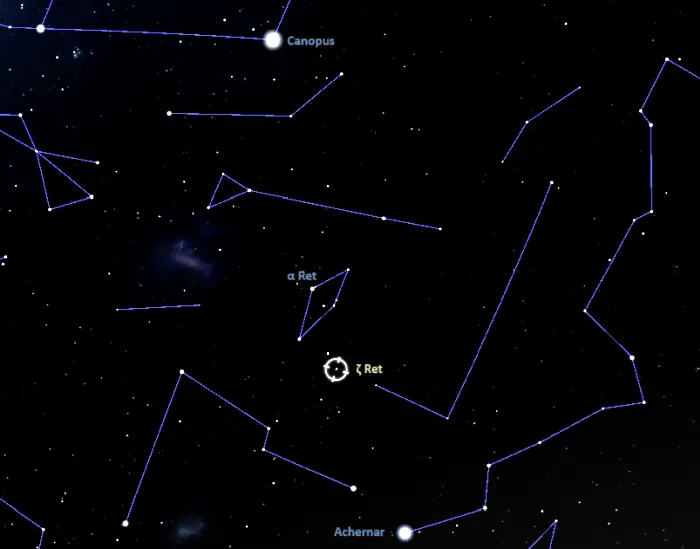
The location of Zeta Reticuli, image: Stellarium
Zeta Reticuli appears as a double star in very dark skies, with no light pollution. It lies at the western border of Reticulum, next to the constellation Horologium.
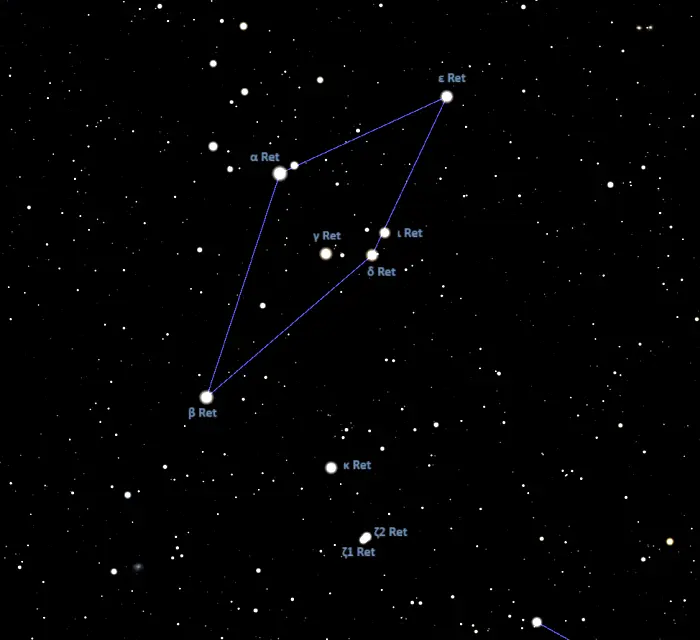
Zeta Reticuli in the constellation Reticulum, image: Stellarium
Constellation
Zeta Reticuli is located in the southern constellation of Reticulum. Reticulum is one of the smallest constellations in the sky. It is the 82nd constellation in size out of 88, occupying an area of only 114 square degrees of the southern sky.
Reticulum is also one of the faintest constellations, with no stars brighter than magnitude 3.00. The constellation’s brightest star, the yellow giant or bright giant Rhombus (Alpha Reticuli), shines at magnitude 3.315.
Other notable stars in Reticulum include the orange subgiant Beta Reticuli, the binary star Epsilon Reticuli, the variable red giants Gamma Reticuli, Delta Reticuli and R Reticuli, and the yellow giant Eta Reticuli. The constellation hosts several stars with orbiting exoplanets, including the orange dwarfs HD 23472 with five transiting planets, HD 27894 with three planets and HD 21749 with two, and the yellow subgiant HD 21693 with two orbiting planets.
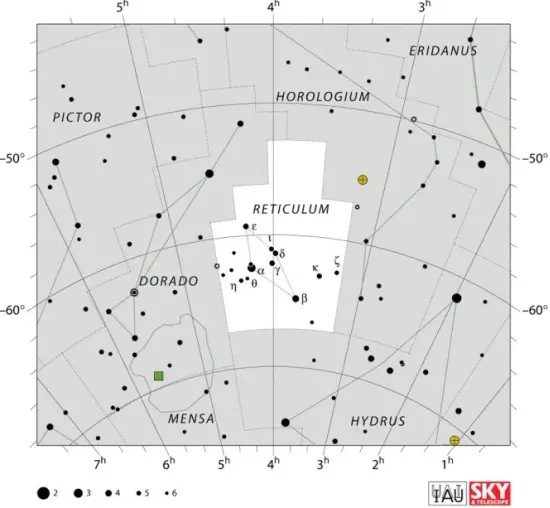
Reticulum constellation map by IAU and Sky&Telescope magazine
Reticulum is one of the 13 constellations introduced by the French astronomer Nicolas Louis de Lacaille in the 18th century. Lacaille’s constellations are inconspicuous and lie in the far southern sky. Most of them represent scientific instruments. Reticulum represents the reticle, a small net built into the eyepiece of a telescope, used to measure star positions.
Notable deep sky objects in the constellation include the dwarf galaxy Reticulum II, a member of the Local Group, and the barred spiral galaxies NGC 1313, also known as the Topsy Turvy Galaxy, a field galaxy in the Virgo Supercluster, and NGC 1559, which hosted a Type Ia supernova observed in 2005.
The best time of the year to observe the stars and deep sky objects in Reticulum is during the month of January, when the constellation rises higher above the horizon in the evening sky. The entire constellation is visible from locations between the latitudes 23° N and 90° S.
The 10 brightest stars in Reticulum are Alpha Reticuli (mag. 3.33), Beta Reticuli (mag. 3.84), Epsilon Reticuli (mag. 4.44), Gamma Reticuli (mag. 4.5), Delta Reticuli (mag. 4.60), Kappa Reticuli (mag. 4.71), Iota Reticuli (mag. 4.97), Zeta2 Reticuli (mag. 5.22), Eta Reticuli (mag. 5.22), and HD 27304 (mag. 5.45).
Zeta Reticuli
| Spectral class | G3−5V + G2V |
| Constellation | Reticulum |
| Names and designations | Zeta Reticuli, ζ Reticuli, ζ Ret, WDS J03182-6230 |
Zeta1 Reticuli
| Spectral class | G3−5V |
| U-B colour index | +0.08 |
| B-V colour index | +0.63 |
| R-I colour indeks | +0.34 |
| Apparent magnitude | 5.52 |
| Absolute magnitude | 5.11 ± 0.01 |
| Absolute magnitude (bolometric) | 5.03 ± 0.03 |
| Distance | 39.28 ± 0.02 light years (12.045 ± 0.006 parsecs) |
| Parallax | 83.0240 ± 0.0438 mas |
| Radial velocity | +12.44 ± 0.12 km/s |
| Proper motion | RA: +1,337.530 ± 0.051 mas/yr |
| Dec.: +649.930 ± 0.154 mas/yr | |
| Mass | 0.94 M☉ |
| Luminosity | 0.761 L☉ |
| Radius | 0.90 ± 0.03 R☉ |
| Temperature | 5,729 ± 60 K |
| Metallicity | -0.25 ± 0.06 dex |
| Age | 1.5 – 3 billion years |
| Rotational velocity | 2.2 ± 0.8 km/s |
| Surface gravity | 4.5 ± 0.1 cgs |
| Right ascension | 03h 17m 46.1634549490s |
| Declination | −62° 34′ 31.152456644″ |
| Names and designations | Zeta1 Reticuli, ζ1 Ret, HD 20766, HR 1006, HIP 15330, SAO 248770, CPD−63°217, GC 3966, GCRV 1837, GJ 136, LTT 1573, NLTT 10575, N30 678, PLX 701.00, LHS 171, LFT 275, ALB 1B, CNS5 829, CPC 20.1 680, IRAS 03168-6245, 2MASS J03174616-6234313, PPM 353436, UBV 3226, UBV M 9460, JP11 772, WEB 2948, SPOCS 158, GEN# +1.00020766, PM 03167-6246, RX J031743.8-623452, 1RXS J031743.8-623452, SKY# 4949, WISEA J031748.15-623424.1, Ci 20 224, TIC 279649057, TYC 8863-1556-1, Gaia DR2 4722111590409480064, Gaia DR3 4722111590409480064, CCDM J03180-6232B, IDS 03160-6253 B, WDS J03182-6230B |
Zeta2 Reticuli
| Spectral class | G2V |
| U-B colour index | +0.01 |
| B-V colour index | +0.58 |
| R-I colour index | +0.34 |
| Apparent magnitude | 5.22 |
| Absolute magnitude | 4.83 |
| Absolute magnitude (bolometric) | 4.79 ± 0.03 |
| Distance | 39.27 ± 0.03 light years (12.039 ± 0.009 parsecs) |
| Parallax | 83.0606 ± 0.0608 mas |
| Radial velocity | +11.94 ± 0.13 km/s |
| Proper motion | RA: +1,331.027 ± 0.073 mas/yr |
| Dec.: +647.725 ± 0.083 mas/yr | |
| Mass | 0.96 M☉ |
| Luminosity | 0.972 L☉ |
| Radius | 0.98 ± 0.03 R☉ |
| Temperature | 5,861 ± 12 K |
| Metallicity | −0.26 ±0.03 dex |
| Age | 1.5 – 3 billion years |
| Rotational velocity | 1.74 km/s |
| Surface gravity | 4.43 ± 0.10 cgs |
| Right ascension | 03h 18m 12.8188824117s |
| Declination | −62° 30′ 22.904711032″ |
| Names and designations | Zeta2 Reticuli, ζ2 Ret, HD 20807, HR 1010, HIP 15371, SAO 248774, CPD−62°265, GC 3975, GCRV 1842, GJ 138, LTT 1576, NLTT 10597, SKY# 4958, PLX 705, LHS 172, LFT 276, PPM 353441, CPC 20.1 685, PM 03171-6242, GEN# +1.00020807, SPOCS 159, IRAS 03172-6241, 2MASS J03181281-6230230, BNU 2, UBV 3233, UBV M 9467, JP11 777, Ci 20 226, CNS5 833, N30 680, WEB 2954, JP11 777, WISEA J031814.85-623015.9, LPM 148, TIC 279649049, TYC 8863-1557-1, Gaia DR2 4722135642226356736, Gaia DR3 4722135642226902656, ALB 1A, CCDM J03180-6232A, IDS 03160-6253 A, WDS J03182-6230Aa,Ab, WDS J03182-6230A |